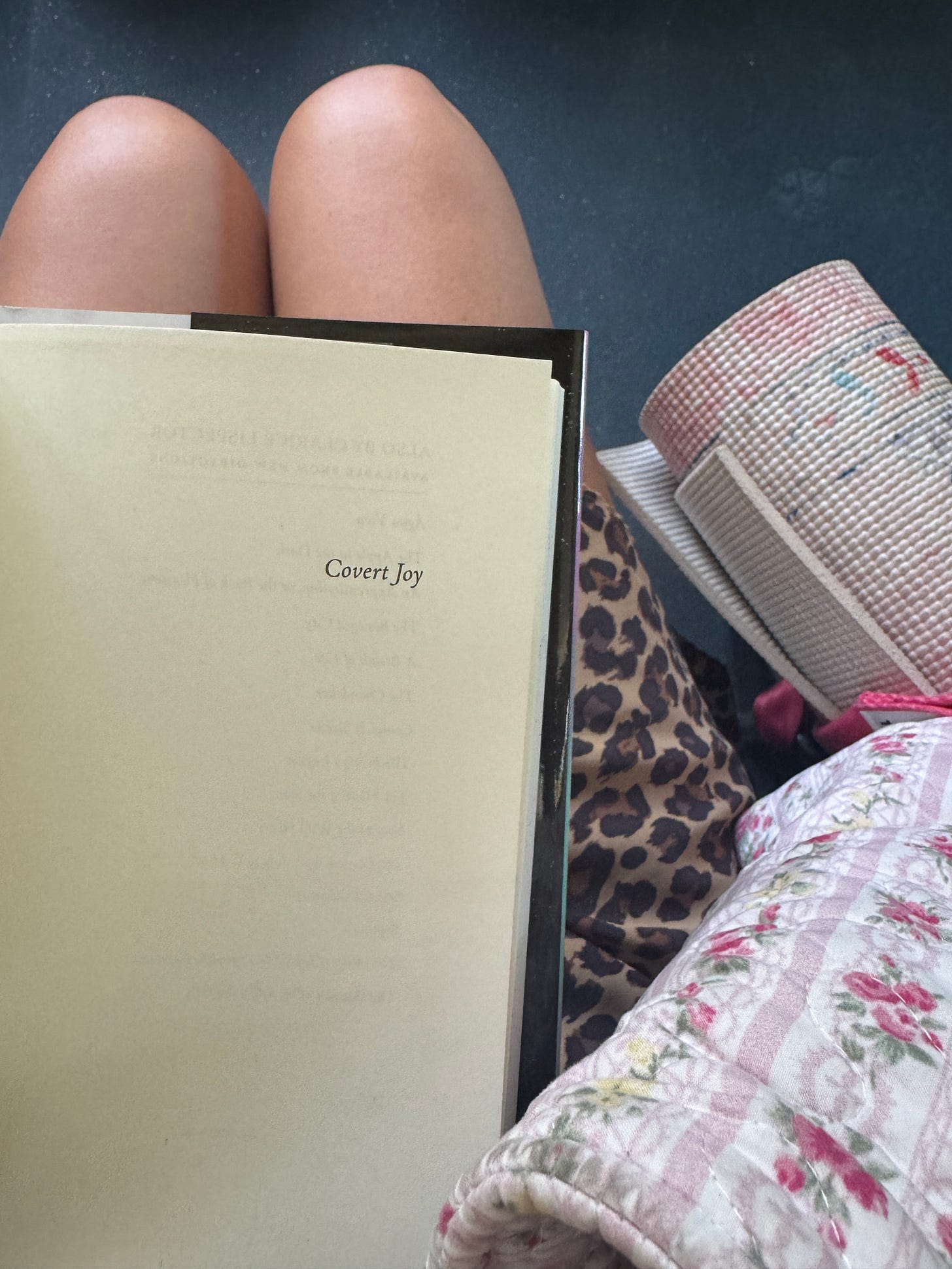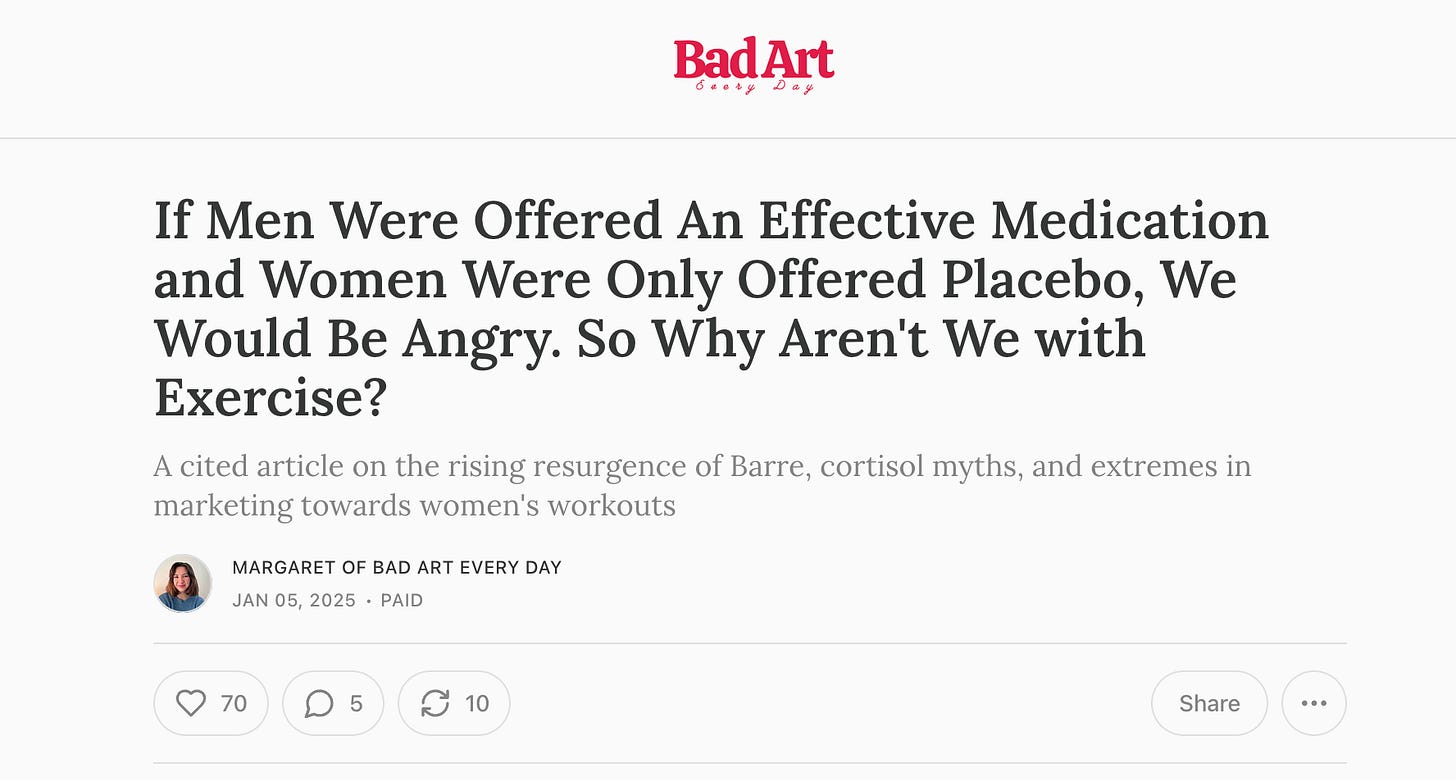I Made A Viral Video Critiquing Pilates. Now I'm Getting Trained to Teach It.
On the purpose of critique, expecting more from women's fitness, and how I'm trying to make my class better
When I was 16, two very exciting milestones were reached in my small town, midwestern life. One is obvious: I could now drive. The second? I could go to the gym that was just a mile down the road with exercise classes, equipment, and a smoothie cafe. This seems like small business, but to a 16 year old who was not that cool, this was a boon.
Over the summers between years of high school, my best friends and I would spend our long days riding bikes to the local pool, meandering the aisles of Hobby Lobby, eating frisco melts and chocolate shakes at Steak’n’Shake, and joining the mostly 35+ folks at the gym for group exercise. While I ran cross country (not well) and played volleyball in high school (even worse), I was by no means naturally athletic. If anything, high school sports were a grueling course of trying to just reach middle of the pack. Meanwhile, in the summer, I got to exercise in whatever way I felt like, and with an invitation to find the challenge that fit me, regardless of what everyone else was doing.
This is how I ended up having my first experience doing classical mat Pilates at the age of 16. The usual class was 3 pm on Sundays, and almost always I was the youngest person there by a decade. This was in 2010, and at that time, Pilates was in a nadir between its peaks in popularity in the 90’s and again now in the 2020s. The mat Pilates I was introduced to was, slow, mostly low-intensity, with an occasionally held plank or bridge for a beat longer than comfortable. It was decidedly not the Hot HIIT Pilates Sculpt that I see on TikTok, and sometimes enjoy myself in real life in 2025. It was a bit boring, but I loved it. It was the first time I understood what a core exercise was meant to feel like, and the mobility combined with core and leg work helped make my mediocre running just a bit better.
As school would start up again, I happened to find a way to add Pilates into my routine when I couldn’t go hang out at the gym—one new, and one older. Online, I began following Casey of Blogilates at the very start of her Youtube channel. As a One Direction fan, her song challenges introduced me for the first time into the concept of “the burn.” I had a teacher from and earlier generation of fitness and Pilates too: Denise Austin home workout DVD’s. She taught me standing Pilates, and the fluidity the movement could have in flow.
Over the coming decade +, I’d find other ways to move, fall off an exercise routine in college, get back into one in medical school, find lifting, re-find running, and circle back to Pilates once a year. This brings me to the last few years, in which my work in eating disorders has led me to explore the science behind the claims of different wellness and fitness trends.
That learning, research, and my deepening lens as a feminist when it comes to health led to dissatisfaction with the field of Pilates, but more broadly with workout spaces that are aimed at and predominantly populated by women. I’ve talked often online for the last few years about my love for the program Evlo Fitness, made by three female physical therapists who want to bring science to women. For the first time in exercise, science was being brought into the equation in a robust, education-minded way. I became better at exercise through Evlo not just because I was practicing their specific format, but because they teached through the whole thing about why we did what we did. Pilates, Barre, Yoga, Sculpt classes—they never offered this. When they did, and I went and found the original research when I could, it was often bad science. The populations were small, the research findings were public but the methodology was near impossible to find, the study was heavily biased, or the placebo was bad. The science—the rare times it was given in a women-centric space—was sparse, and the understanding being taught prior to doing Evlo was superficial at best.
Then Why Teach?
When I dislike a systemic issue in an area in my life, two choices often emerge: either leave the system for something different and hopefully better, or stay in the system and try to better it from within. I work in healthcare, I am a progressive Christian, and I am a therapist—holding complexities in painfully imperfect places has become a bit of a specialty of mine.
Pilates offered me something at 16 that made me love it then, and still love it now, even with caveats. First, as many pointed out in my viral video, Pilates types of classes allow women to feel more safe than many other fitness contexts. The spaces are often filled with natural lighting, pretty colors, interesting accessories, and, most importantly, other women. This is not a space you will be oggled, harassed, bullied (minus the part of the beauty standards of Pilates…that’s for another day) in the way you would at a big box gym or cross fit. At the core of Pilates’ philosophy is instruction towards listening to one’s own body and seeking the right progression and challenge for you. It is not about pushing through the signals your body is trying to give you, and it is not about being stagnant with no challenge. Pilates can have a flow, a lyricism, and a musicality that, besides dance, can be hard to find in other fitness spaces. Lastly, Pilates can have blended approaches that build strength in a gentle way and offer needed mobility for the modern, desk-based, cognitively-overloaded worker.
I used to teach Barre in medical school to undergrads, and it was both nerve-racking and creatively invigorating. The further I get into working in eating disorders, the more I see the potential of how fitness communities shape and encourage us—maybe physically, but definitely mentally. I kept going to all sorts of classes in the last few years and thinking, “Why can’t I find a class where science and body-kindness are at the center?” I’d spend the 15 minutes after class talking to instructors on how I liked their flow or sequencing. I’d spend even longer on my walk home thinking about how I could add in parts to create real progressive strength training alongside the mat work that was more classically Pilates.
At some point, if something both pisses you off and creatively engulfs you, you pursue it. And so, I did.
This summer, I’ve been working on becoming Power Pilates Mat certified. I’m learning the classical method as intended, and suspending some of my critiques to understand the method in my own body. A few weeks ago, I went for an audition at a local studio chain in Boston, mostly as a way to practice auditioning for the future as I figured I would do my best, but not very well, on my first go.
However, I only needed one go, as I got hired. I’m working now on onboarding, scheduling and logistics, but will begin teaching a Pilates x Strength class this fall, including teaching in Cambridge, where I’ll get to work around young adults who are learning like I did what it means to move as a mode of care for yourself once you no longer have practice after school each day.
My class will be iterative, and it will be a blend of what I’ve learned from 15 years of different forms of Pilates, what I learn as I stay in my classical community, and what I’ve been taught through reading of the primary literature, following lifters for years, listening and practicing through Evlo and the many physical therapists I’ve followed. It won’t need to be perfect—it just needs to be growing. Attuning to the next moment’s challenge with fluidity and effort—that is perhaps the biggest thing I’ve learned from Pilates in the first 15 years.
Who knows what will come next?
Take care, and take your time,
Margaret of Bad Art Every Day




